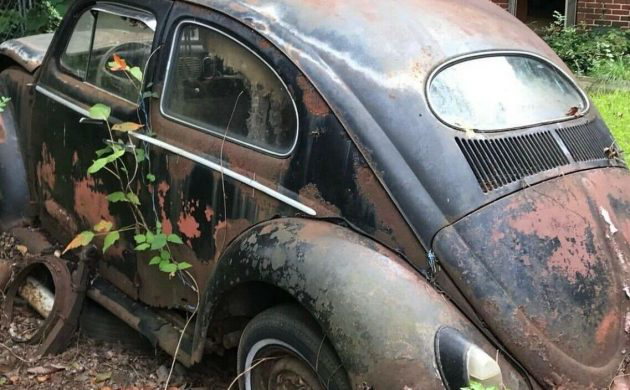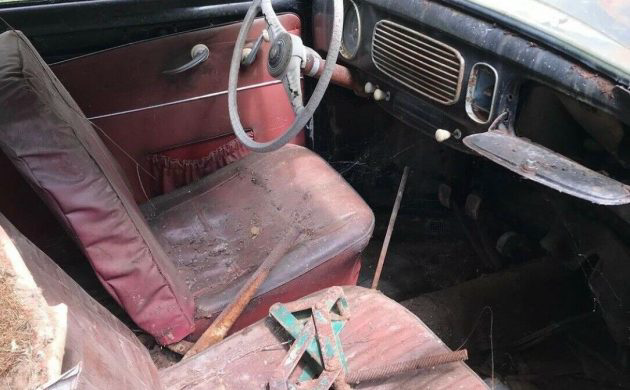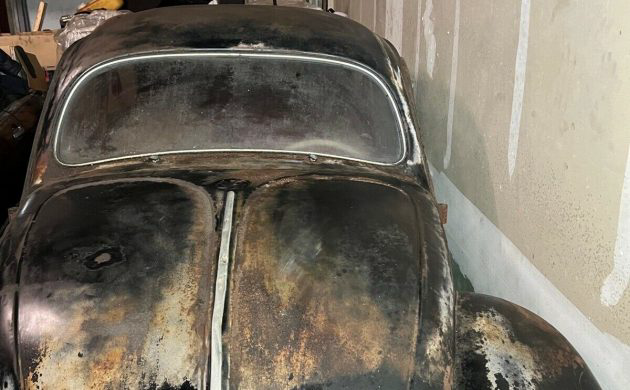For as long as the original Volkswagen Beetle has been around, there have been some constants: California-look Bugs are always cool; original Beetles are worth the most; and the earliest models with their oval rear windows and “semaphor” turn signals are among the most desirable specimens you can get. In most cases, the earliest or latest examples of a particular make or model are the most sought-after by collectors, but in the case of the air-cooled Beetle, the earliest days of the groundbreaking economy car also saw it come with numerous short-lived details that would not survive past the first refresh, making rough-but-complete examples like this ’55 model here on eBay a tempting project car for air-cooled fanatics. Bidding is at $3,300 with no reserve.
The seller maintains he has owned this Beetle for many years, and that it was purchased as a project that hasn’t seen much in the way of love. I totally get this, as these days I’ve figured out a few different storage arrangements that (unfortunately) allow me to snag potential projects to sit on and determine at a later date if they’re worth moving forward on. I wonder if this seller was waiting it out to see if early Beetles were going to explode in value like its sibling the Porsche 356 did; sadly, the train has left the station and I don’t see early Beetles ever achieving the same level of sales success despite its close relation to the early versions of the classic sports car. This Beetle wears a handsome color combination of black over red, but the seller notes the floors are rough.
The must-have details are here, including the semaphore turn signals that pop out of the B-pillar to indicate which direction you intend to travel. Some Beetles have these retrofitted to look like early models, and some early models lost the novel feature many years ago. No matter how you look at it, the qualities that make an early Beetle so desirable are certainly unique but not just limited to safety features; the oval rear window is purely a cosmetic matter but one that makes all the difference to the air-cooled faithful. Again, some Beetles have had oval back windows retrofitted to their bodies, but finding the real-deal early model is the best way to ensure you’ll get your money back out of the restoration costs should you ever decide to sell – they are generally that sought after.
The paint is rough and there’s damage to the passenger-side fender, but the seller is including the necessary replacement panel. It sounds like you’ll be on your own for sourcing replacement floors, but they are widely available for an air-cooled Beetle. The seller will include a bevy of extra parts, including snowflake taillights, exhaust pipes, mirrors, and hubcaps. Perhaps most importantly? The engine is the correct, numbers-matching assembly from 1955, which would have been a difficult motor to find in the correct vintage if it were missing. This is a project, but a deserving one that will always be worth saving given its early brand provenance.






This Beetle is old enough that someone will hopefully restore it. Beetles seem to be commanding higher prices but are the higher resale values just due to the whole classic car movement? I recently watched a YouTube video where I discovered the Beetle wasn’t the idea of it’s creator Ferdinand Porsche but owes its design to the Tatra. Here is the link for anyone interested in the history of cars of the Czech Republic.
https://www.youtube.com/watch?v=Faf1P97v-_4
Ahoi alphasud,
thanks for this video. In my opinion it has a lot of information about czech car history and – it`s not boring. Of course it can`t be complete. For example I miss one of my favorit prewarcars – the JAWA Minor. But there are also some slightly mistakes in this video. Of course a VW Beetle was never ever a eastern german car. But it`s true, there were some western european cars in CSSR. A lot of the western cars came from france. The FIAT cars came most of the time not from italy, they also came from the east block, like from Jugoslavia or Poland. By the way, in 1990 I was wondering how much non east block cars were on the streets of Prague. In the video the Skoda 120 was shown. A lot of people from eastern germany wanted in this time such a car. They had to wait about 15 years for a new car and parts were also a problem. If you compare for such a long time a Skoda 120 to a Trabant 601, Wartburg 353 or a Lada 2107 you know why they wanted the Skoda. By the way, people could even buy a Skoda 120 in Sweden, the neutral country from Saab and Volvo. But this are details, doesn`t matter. A really nice thing in this film is, that the author mentioned Hans Ledwinka and his conection to the VW Beetle. This is a long story and not everybody tells it. Sometimes you can even read that Ferdinand Porsche was the only inventor from the Beetle – such things, are complete nonsense. Of course I also don`t know every detail, but…, well…, I know it`s a never ending story… Alphasud, one last thing I want think about it. I don`t know if it`s worth to save this 1955 VW Beetle. Of course it`s worth to save a lot of parts from this car. But if somebody wants to build a high quallity hot rod out of it, I would not care. VW Beetles are not rare. Ok, it`s a 1955 and thats more intressting like a 1977, of course. A 1947 Beetle in similar condition would be worth to restore. I am not sure about this 1955 one.
Best regards,
Till J.
Ed does some really good episodes of his history of cars, and this one is very good. But as a person who has researched the Tatra company and has owned multiple Tatra cars, I have a couple of Tatra comments;
When Ed mentions Tatra tried to sue Porsche for patent infringement, and the timing was wrong, he didn’t mention that after the war the Tatra company filed suit in West German court. In 1962 the court came to the decision that Porsche/VW had indeed used Tatra patents, and the company was awarded 1,000,000DM*, as well as a 1DM royalty on every VW rear-mounted air-cooled engine. *[About $250,600.]
What Ed also didn’t mention was the fact that a pre-WW2 Tatra was introduced just as the war began, called the type 97. It had a 4 cylinder, air cooled, rear mounted engine with transaxle. It should be noted that a VW engine would bolt up to the Tatra 4 cylinder transaxle as well as the pre-war Tatra T-87, and the VW engine also fits the Postwar Tatraplan T-600 without any modifications.
How did that happen? If 2 different product specifications are so identical that they can be interchanged, then the only logical reason is because the blueprints and specifications were used. It’s true: Porsche used the Tatra flat 4 air cooled engine in the VW, with slight modifications like the cooling shields. Even the novel way of adjusting the fan belt was the same — using spacers between the pulley halves on the generator.
“Floors are rough”; aye, and the next six inches up…
Where’s the engine?
Its in Florida so scrap it there is going to be to much hidden rust
I seriously love old VWs… But you’ld really have to want one bad to take this one on! Any car sitting outside on the ground is in deep trouble. A car sitting outside on the ground in Florida is doomed to a rust induced fate. The semaphore ovals and splits are very valuable in the VW circles, so this one will most likely be harvested for the top and scant other bits & pieces that may be salvageable. Shame.
“…the earliest days of the groundbreaking economy car also saw it come with numerous short-lived details..”. How long did they make the split window Beetle?
1955 was the last split window. My dad had a ’56 and it had the small oval window.
I’m pretty sure ‘54 was the last year for split windows. ‘55s had the regular oval window and ‘56 got the top bar on the bumpers.
Officially, the last Split Window was in 1952. Ovals were ’53 to ’57. As they say, “Look it up”. That said, there is a very “gray area”. Some folks are posting that so-and-so had a Split, and it was a ’53. Here’s the deal. Like many manufacturers, VW had enough “Split Window” tops/window sections to continue making them. They made “Split Windows” until they ran out of those pieces. That took them into the beginning of the ’53 production year. HOWEVER, what makes these cars quite unique is the interior of the car. Primarily the doors and the dash, which were absolutely the design used in the upcoming “Oval” cars. These transition cars are now called “Zwitters” . . . a sort of “half and half” car. They are one of the most sought after early VWs of all time. If you find a “Zwitter”, look inside: the doors are not “ribbed”, and the dash is the “new” dash. As for the bumpers, that was mainly an “import” vs. home market car, or the “deluxe” version.
For those who want to know, the last year of the split window for the Bug was 1952, one piece oval ran fro1953 to 1957. Also, for the listed Bug if you did not have the semaphore turn indicators in 1955, you would have the flashing directional indicators mounted low on the front fenders. The 1954 Bug saw lots of new changes from previous years and the 1956 saw even more.
They absolutely made split windows in ’53. My buddy has one. Don’t believe me? Google it.
I thought the semaphores were only on foreign spec cars and not for U.S. import.
I read, ’54 was the last year for semaphores in the US, but still retained them until 1960 in Canada and Europe. This could be a very late ’54 titled as a ’55 or from Canada. This is a great site for “changes through the years” on VW’s.
http://www.vw-resource.com/years.html
RKS, your buddy would have had an early version ’53 bug so you are correct. They made the split window version in ’53 till March 10, 1953. Then they were oval up thru the ’57 model year. CCD
I like it.
The rear window isnt a styling treatment. The older ones had split windows as they hadn’t figured out how to make curved tempered glass. The oval window came out when they figured it out but hadn’t perfected it. Keeping it small meant a lesser curve. By 58 they could make a “big” back window.
Brings back memories of my dad’s ’56. The rear windows were stationary, so my brother and I would cook in the summer, not to mention the funky odor the carpet gave off. I remember there was no gas gauge, so when the tank was empty and the car started to sputter, my dad would kick a lever on the floor that activated the reserve tank.
Everybody has their “beetle stories”. I wonder if time (and breathing the VW heater fumes?) has some of us confused. I recall a family friend had a PINK split window bug..Well, it had been blue and painted pink, except for two hand outlines on the engine lid. I BELIEVE that my older sister and I used to ride in the “way back” which is the parcel shelf behind the back seat and each of us had our “own window” that way. Much older at 6’3″ and 235# I look at that space and go “Uhh..no way……really?” Different times, WAY different cars….
Clean it up, find a Porch engine and enjoy.
The hardcore VW folks will be fighting for this vehicle. Oval window and semaphores. If it only had the gas-powered heating unit in the front trunk.
I have killed many VW’s and rigged them along the way. Bugs,buses, Vans,et al! I should be an expert. Also 35 years resto shop owner. But alas!! Amateur restorers are the only ones that can profit from VW resto. Lots of experts there. Saw 20 of them saturday at the Huntington Beach C$C. YAWN!
SOLD for $3,800.